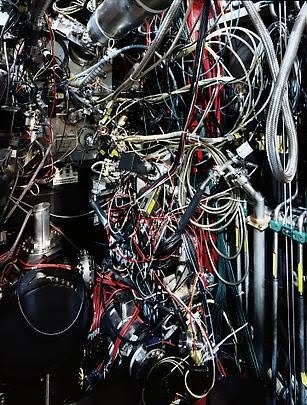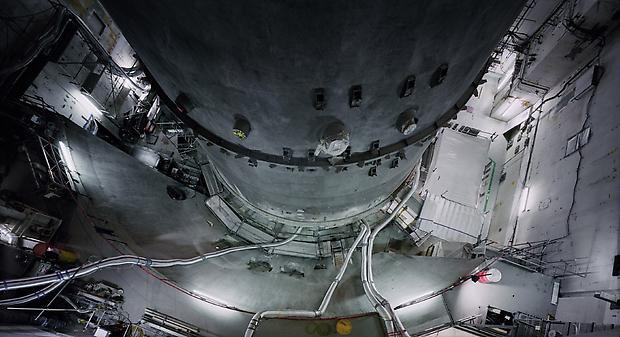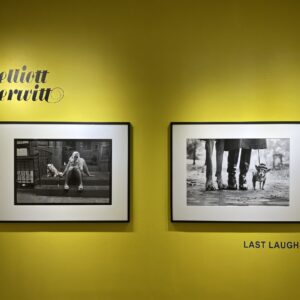 JTF (just the facts): A total of 16 large scale color works, framed in white with no mat, and hung against white walls in divided spaces in the north and south galleries. All of the images are c-prints, in editions of 10, made between 2007 and 2010. Sizes vary from 45×35 to 113×140. An exhibition catalogue is available from the gallery for $40. (Unfortunately, no photography was allowed in the galleries; as a result, there are no installation shots for this exhibit. The images at right were taken from the gallery website. Tokamak Asdex Upgrade Periphery, Max Planck IPP, Garching, 2009, at right.)
JTF (just the facts): A total of 16 large scale color works, framed in white with no mat, and hung against white walls in divided spaces in the north and south galleries. All of the images are c-prints, in editions of 10, made between 2007 and 2010. Sizes vary from 45×35 to 113×140. An exhibition catalogue is available from the gallery for $40. (Unfortunately, no photography was allowed in the galleries; as a result, there are no installation shots for this exhibit. The images at right were taken from the gallery website. Tokamak Asdex Upgrade Periphery, Max Planck IPP, Garching, 2009, at right.)
Comments/Context: Thomas Struth’s new images of cutting edge science and technology facilities examine the often messy reality of 21st century experimentation and innovation. In the past several years, he has visited nuclear reactors, pharmaceutical clean rooms, shipbuilding docks, the Kennedy Space Center at Cape Canaveral, and the Max Planck Institute for Plasma Physics, gaining access to the areas behind closed doors where the real work is going on. His photographs tell a complex story, of ambitions and aspirations to understand and change the world, and of incomprehensible contraptions and unlikely structures built to enable our visions.
Most of the photographs in this show are both formal in execution and dense with information. Many focus on up-close jumbles of wires, tubing, pipes, insulation, and gauges, swirled and clustered into spaghetti, or rigidly ordered and overlapped to maximize the use of available space. Copper flashing, steel bolts, plastic tape, rubber sheathing, metal scaffolding, electronics and bubble wrap are alternately added to the ungainly mix to achieve a wide variety of technical results. Often taken from above, the deadpan compositions are flattened out into abstract collections of line and color. To the untrained eye, science looks an awful lot like trial and error tinkering, barely ordered chaos or maybe just a pile of junk; Struth’s images expose a layer of subtle awe-inspiring, ridiculousness (how could that possibly work?) lying hidden underneath our futuristic potential.
 In the case of a shipyard, a reactor, or the Space Shuttle, the complexity gets increased exponentially by the massive scale of the endeavor. (Reactor Pressure Vessel Phase Out, AKW Würgassen, Beverungen, 2009, at right.) In all three cases, extra parts lie scattered everywhere, and layers of additional structure are required just to maintain what already exists. The criss-crossing wires that anchor the shipyard to the mainland are all perfectly logical, but also seemingly crazy when seen shooting out in all directions. Similarly, while the heat-resistant tiles on the underside of the Space Shuttle look surprisingly like perfectly patterned armadillo skin, it is the disarray of tripods, ladders, and testing equipment gathered below that really makes you wonder about how the work actually gets done.
In the case of a shipyard, a reactor, or the Space Shuttle, the complexity gets increased exponentially by the massive scale of the endeavor. (Reactor Pressure Vessel Phase Out, AKW Würgassen, Beverungen, 2009, at right.) In all three cases, extra parts lie scattered everywhere, and layers of additional structure are required just to maintain what already exists. The criss-crossing wires that anchor the shipyard to the mainland are all perfectly logical, but also seemingly crazy when seen shooting out in all directions. Similarly, while the heat-resistant tiles on the underside of the Space Shuttle look surprisingly like perfectly patterned armadillo skin, it is the disarray of tripods, ladders, and testing equipment gathered below that really makes you wonder about how the work actually gets done.
Having lived a life of technology, I am familiar with the workings of clean rooms, testing facilities, and factory floors, and so these pictures didn’t necessarily show me anything I haven’t seen before in countless other places. But instead of seeing these venues with my usual combination of impressed wonder and future-oriented confidence, I was forced by Struth’s images to admit to seeing the absurdity of it all, to acknowledge the imperfections and stop gaps being regularly employed to keep it all running. It’s a Wizard of Oz moment – the curtain has been pulled back, revealing that our precise, systematic genius might also, from time to time, manifest itself as something altogether less glamorous – fragile, cobbled together, and on the verge of potential breakdown.
Collector’s POV: The prints in this show range in price from 45000€ to 275000€ roughly based on physical size, with most of the works priced at 90000€. Struth’s photographs are consistently available in the secondary markets, with prices starting as low as $5000 and rising all the way past $1000000, with large, well known pieces routinely fetching six figures.
Rating: ** (two stars) VERY GOOD (rating system described here)
- Upcoming retrospective @Kunsthaus Zurich, 2010 (here)
- Interview with Gil Blank, 2007 (here)
- Reviews: NY Times, 2007, (here), artcritical.com, 2005 (here)
- Retrospective @Met, 2003 (here)
Thomas Struth
Through June 19th
Marian Goodman Gallery
24 West 57th Street
New York, NY 10019




